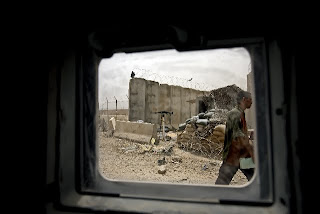



Ben's work is powerful and insightful. I follow politics, politicians and the war pretty closely, so when I saw this work I was immediately taken with it. To me it exemplifies the way we grasp what is happening in Iraq, how we see a different culture, and why we don't understand what happens to our families when our soldiers come home.
I have been trying to consolidate my feelings for this post, and I end up frustrated, trying to stay neutral. I just can't. I know, its my blog and I can say what I want. But this blog is about images, and the photographers who created them. So I found this wording from a PDN post Ben had done in June of this year. It says it all. Thanks to PDN and to Ben for letting me share.
In Ben's words -
In July 2005 I was being driven from an assignment—an endeavor that took two cars and 4 heavily armed Iraqi guards—when my mother called. She asked me if I had the chance to go to a shopping mall with Iraqis. Mouth agape, I told her that something like that is impossible, dangerous for someone like me—tall, white, and bald. I told her that I couldn’t go anywhere without guards, or without US soldiers—that Iraq was a land of blast walls and barbed wire fences. She replied that she had no idea, that she never saw any photographs or news reports illustrating what I had described. That was when I made my first image of a concrete blast wall through the window of my armored car.
“Iraq | Perspectives grew immediately out of that conversation, and as a response to what I felt was the general apathy and inability of people in the US to comprehend what Iraq is like. Confronted by a level of violence so high that walking on the streets to photograph is tantamount to suicidal behavior, I found myself confined to working with American soldiers, spending most of my time going on various missions in armored Humvees. My only view of Iraq was through the inches-thick bulletproof window.
“I wonder if Iraqis see me through these windows? I don’t know. But they do see the monstrous convoys of Humvees coming down the roads of their neighborhoods. Some stop to stare, some jeer, some cheer (rare), some just go about their business, oblivious to the tons of destructive force driving by. This view of the Iraqi street is one so rarely seen by the American public, but it is the most common sight for US soldiers. Do these soldiers see the Iraqis as they speed by? I’m not sure.
“I strive to create images that will hopefully overcome the public’s apathy to news pictures from Iraq. Metaphorically speaking, these windows represent a barrier that impedes dialogue. These pictures show a fragment of Iraqi daily life taken by a transient passenger in a Humvee. The images are not intimate—they often show a distant and detached perspective of a country so empty, so desolate and of a situation so dire.”

